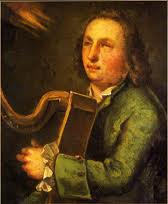Annotation:Miss Fetherston: Difference between revisions
(Created page with "'''Back to [[{{BASEPAGENAME}}]]''' ---- <p><font face="garamond, serif" size="4"> '''MISS FETHERSTON.''' AKA and see "Carolan's Devotion" (Brabhadh Cearbhallain), "[[O'Car...") |
m (Text replacement - "garamond, serif" to "sans-serif") |
||
| (5 intermediate revisions by 2 users not shown) | |||
| Line 1: | Line 1: | ||
'''Back to [[{{BASEPAGENAME}}]]''' | '''Back to [[{{BASEPAGENAME}}]]''' | ||
---- | ---- | ||
<p><font face=" | <p><font face="sans-serif" size="4"> | ||
'''MISS FETHERSTON.''' AKA and see "[[Carolan's Devotion]]" (Brabhadh Cearbhallain), "[[O'Carolan's Devotion (2)]]." Irish, Air or Planxty (3/4 time, "animated"). G Minor (O'Neill): G Dorian (Complete Collection, O’Sullivan). Standard tuning (fiddle). AAB. | '''MISS FETHERSTON.''' AKA and see "[[Carolan's Devotion]]" (Brabhadh Cearbhallain), "[[O'Carolan's Devotion (2)]]." Irish, Air or Planxty (3/4 time, "animated"). G Minor (O'Neill): G Dorian (Complete Collection, O’Sullivan). Standard tuning (fiddle). AAB. Composed by the Irish harper Turlough O'Carolan, most likely in 1720 or 1721 (though Bunting gives dates of "about 1700" and, elsewhere, 1690). Walker (in '''Irish Bards'''), on authority of harper Charles O'Connor, relates the tale of the composition of the tune. It seems that a Miss Fetherston, of County Longford, chanced upon O'Carolan one Sunday on the way to Mass and, knowing of his fame and admiring his music, she introduced herself and invited him to visit her house. He promised to do so, and while at Mass, "instead of praying for Miss Fetherston as she requested, he neglected his religious duties to compose a song for her." It was the only time O'Carolan wrote words in English, "an act of poetic gallantry, as the young lady did not understand Irish." O'Sullivan (1983) thinks it probable that Miss Fetherston was a sister of Thomas Fetherston of Ardagh, near Edgeworthstown, County Longford, who married about 1709. | ||
[[File:carolan.jpg|200px|thumb|left|Turlough O'Carolan]] | |||
<br> | <br> | ||
<br> | <br> | ||
| Line 9: | Line 10: | ||
<br> | <br> | ||
</font></p> | </font></p> | ||
<p><font face=" | <p><font face="sans-serif" size="4"> | ||
''Source for notated version'': | ''Source for notated version'': the Neale's '''Collection of the Most Celebrated Irish Tunes''' (Dublin, c. 1726) [O'Sullivan/Carolan]. | ||
<br> | <br> | ||
<br> | <br> | ||
</font></p> | </font></p> | ||
<p><font face=" | <p><font face="sans-serif" size="4"> | ||
''Printed sources'': '''Complete Collection of Carolan's Irish Tunes''', 1984; No. 48, p. 50. Neale | ''Printed sources'': | ||
'''Complete Collection of Carolan's Irish Tunes''', 1984; No. 48, p. 50. | |||
Neale ('''A Collection of the Most Celebrated Irish Tunes'''), c. 1726; p. 22. | |||
O'Neill (Krassen), 1976; p. 228. | |||
O'Neill ('''Music of Ireland: 1850 Melodies'''), 1903; No. 631, p. 112. | |||
O'Neill ('''Irish Minstrels and Musicians'''), 1913; p. 74 (as "O'Carolan's Devotion"). | |||
O'Sullivan/Bunting ('''Bunting's Ancient Music of Ireland'''), 1983; No. 73, pp. 114–116. | |||
O'Sullivan ('''Carolan: The Life, Times and Music of an Irish Harper'''), 1958; No. 48, p. 128. | |||
<br> | <br> | ||
<br> | <br> | ||
</font></p> | </font></p> | ||
<p><font face=" | <p><font face="sans-serif" size="4"> | ||
''Recorded sources'': <font color=teal></font> | ''Recorded sources'': <font color=teal></font> | ||
</font></p> | </font></p> | ||
Latest revision as of 14:22, 6 May 2019
Back to Miss Fetherston
MISS FETHERSTON. AKA and see "Carolan's Devotion" (Brabhadh Cearbhallain), "O'Carolan's Devotion (2)." Irish, Air or Planxty (3/4 time, "animated"). G Minor (O'Neill): G Dorian (Complete Collection, O’Sullivan). Standard tuning (fiddle). AAB. Composed by the Irish harper Turlough O'Carolan, most likely in 1720 or 1721 (though Bunting gives dates of "about 1700" and, elsewhere, 1690). Walker (in Irish Bards), on authority of harper Charles O'Connor, relates the tale of the composition of the tune. It seems that a Miss Fetherston, of County Longford, chanced upon O'Carolan one Sunday on the way to Mass and, knowing of his fame and admiring his music, she introduced herself and invited him to visit her house. He promised to do so, and while at Mass, "instead of praying for Miss Fetherston as she requested, he neglected his religious duties to compose a song for her." It was the only time O'Carolan wrote words in English, "an act of poetic gallantry, as the young lady did not understand Irish." O'Sullivan (1983) thinks it probable that Miss Fetherston was a sister of Thomas Fetherston of Ardagh, near Edgeworthstown, County Longford, who married about 1709.

In an interesting aside O'Sullivan relates that the young Oliver Goldsmith visited the town of Ardagh and inquired as to the whereabouts of the local inn. A practical joker gave him directions of Squire Fetherston's house (probably a brother or nephew of O'Carolan's Miss Fetherston, says O'Sullivan), where he comported himself as if he were at an inn, ordering dinner and magnanimously inviting the Squire and his daughter to join him at his table. "It was this incident that suggested the plot of 'She Stoops to Conquer.'"
Source for notated version: the Neale's Collection of the Most Celebrated Irish Tunes (Dublin, c. 1726) [O'Sullivan/Carolan].
Printed sources:
Complete Collection of Carolan's Irish Tunes, 1984; No. 48, p. 50.
Neale (A Collection of the Most Celebrated Irish Tunes), c. 1726; p. 22.
O'Neill (Krassen), 1976; p. 228.
O'Neill (Music of Ireland: 1850 Melodies), 1903; No. 631, p. 112.
O'Neill (Irish Minstrels and Musicians), 1913; p. 74 (as "O'Carolan's Devotion").
O'Sullivan/Bunting (Bunting's Ancient Music of Ireland), 1983; No. 73, pp. 114–116.
O'Sullivan (Carolan: The Life, Times and Music of an Irish Harper), 1958; No. 48, p. 128.
Recorded sources:
Back to Miss Fetherston
